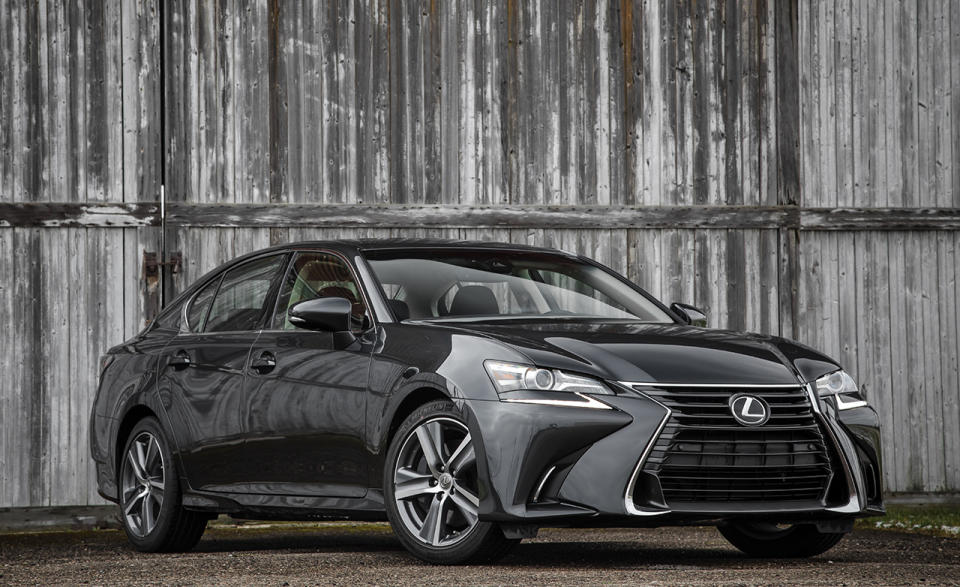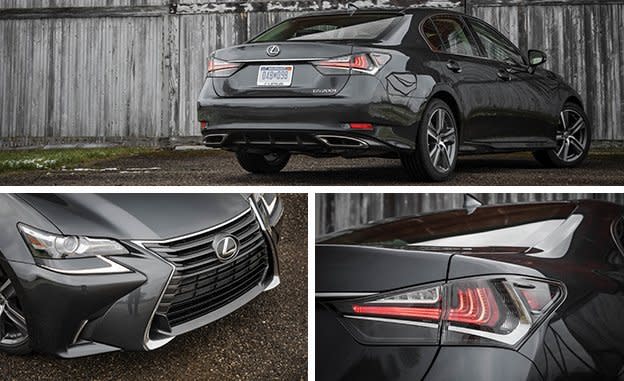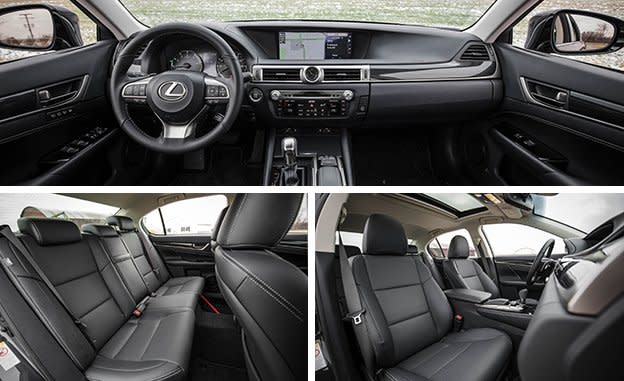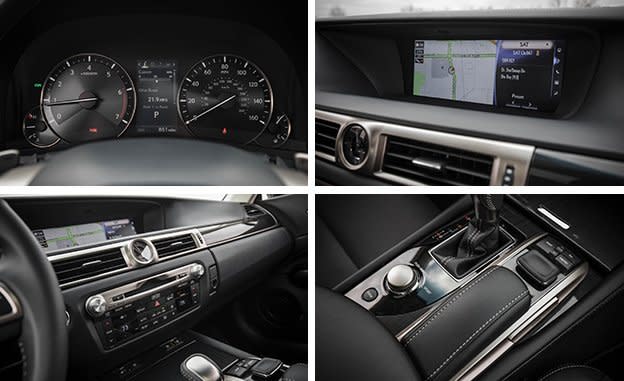2017 Lexus GS200t

When the Lexus GS arrived in the early 1990s—the original Giugiaro-designed one—its mission was to challenge the reigning mid-size luxury sedans from Audi, BMW, Jaguar, and Mercedes-Benz. Accordingly equipped with a choice of V-6 or V-8 engines, the second-generation model made such a convincing case that it won 10Best Cars accolades for three years running (1998 through 2000). It has been some time, though, since we could rank the GS at the top of the field. The current, fourth-generation GS is in its fifth year of production and finds itself squaring off against a Mercedes-Benz E-class and a Jaguar XF that were new in 2016, an Audi A6 that was facelifted last year, and an all-new 2017 BMW 5-series.
Lexus isn’t standing still, though. For its 2016 midlife refresh, Lexus added the value-priced base model tested here with a turbocharged 2.0-liter four-cylinder engine that makes 241 horsepower and 258 lb-ft of torque. That engine gives the newest GS variant a direct match for the 500-cc-per-cylinder fours that most of the European brands now have in equivalent models. The tail badge says GS200t, although the marketers call it the GS Turbo because, well, because Lexus marketers never had a turbo before, and it comes at a starting price that leaves some breathing room below $50,000, something you won’t find if you shop mid-size premium sedans at the German stores.

Green t
In turbo 2.0-liter rear-drive form, the GS’s direct alternatives narrow to the BMW, the Mercedes-Benz, and the Cadillac CTS. The base Audi A6 and the Volvo S90 are front-wheel drive, and the Jaguar XF’s four-cylinder is a 180-hp turbo-diesel. The Cadillac’s turbocharged four is the outlier here, leading the pack with 268 horsepower, while the others cluster near 240.
With the only available transmission being a paddle-shifted eight-speed automatic, the 200t zipped from zero to 60 mph in 6.6 seconds at the test track. We saw 60 mph in 6.5 seconds in the 2017 Mercedes-Benz E300 with 4MATIC, while the CTS 2.0T did it in 6.2 and the A6 2.0T Quattro in 6.1. The BMW 528i needed only 5.9 seconds, but it’s being replaced for 2017. Note that the Benz and the Audi were all-wheel-drive cars, an option Lexus reserves for the six-cylinder GS350.
While it’s clearly not the quickest, the Lexus doesn’t feel inordinately slow. As long as the boost is up, it’s torquey enough to feel peppy moving its 3896 pounds in routine driving situations. Only at higher speeds does the drivetrain falter—and then only when you need to accelerate quickly. It takes a moment for the eight-speed to find the right gear and tap into the engine’s powerband, requiring that the driver plan ahead for a two-lane passing maneuver. This is not atypical for sedans this large with a 2.0-liter turbo four-cylinder. The payoff is improved fuel economy: We measured 24 mpg in our testing, below its EPA combined rating of 26 mpg but much better than the 19 and 20 mpg we’ve measured in tests of the GS350.

Where this car excels is in its easygoing demeanor. The GS200t glides along, unperturbed by pavement irregularities, yet it remains composed on a challenging road. Aside from a little body roll, its chassis measures up in this field, returning a solid 0.86 g on the skidpad. The GS also stopped from 70 mph in 173 feet, a good but not outstanding performance for this class.
For those seeking to amp up the driving fun, Lexus offers an F Sport version of the GS Turbo. It brings a tauter suspension and a lot of other features but adds $7670 to the price, which puts it within $1000 of the $55,785 sticker on a GS350 F Sport with the stronger 311-hp V-6.
Still Searching
Lexus designers seem to be grasping for ways to make their infotainment controls distinctive, without much success in making them functional. There’s a clumsy touchpad in the NX crossover, while in models such as this GS, Lexus still employs a vague and inconsistent two-finger floating controller on the center console that continues to frustrate. It’s like a poorly made version of the joysticks on the portable Sony PlayStation and demands too much attention to be a viable control option while driving—this is a case where Lexus would do well to follow some competitors who have replaced or augmented their similarly awkward remote controllers with touchscreen activation. The 12.3-inch multimedia screen that comes as part of the $1730 Navigation package, though, is well organized and gorgeous, and it offers split-screen viewing.

The infotainment story is disheartening, because the GS has an otherwise cordial cabin. The heated and ventilated perforated leather seats are supportive, the brushed-metal accents look classy, and the tight fits and surface finishes measure up to class standards. Our test car had some textured black trim that looked a little cheap on close examination but also avoided the problems posed by the widely used shiny piano-black alternative that emphasizes fingerprints and looks good only in the showroom. Lexus offers optional aluminum and open-pore wood trim, but they’re not quite as handsome as those found in the Volvo and Mercedes cabins.
The now familiar GS’s 192.1-inch overall length is the shortest in the field, but the packaging works out well, yielding 98 cubic feet of interior space, only fractionally smaller than the Volvo S90 (the CTS tops the field at 101 cubes). The 18-cubic-foot trunk spanks its competition, which averages around 14, but the rear seats don’t fold to expand the cargo hold. Rear-seat legroom can feel tight for adults over six-feet tall, and the center tunnel is tall and wide. The front center console can be opened only if it’s slid rearward on its track, which makes the rear center position even less useful—if you’re traveling any distance with a fifth occupant, one of them had better be a child.
For Lexus, this turbo engine makes a lot of sense. The powerplant already existed in the brand’s portfolio (it also is found in the IS200t and NX200t) and it improves fuel economy in a mid-size sedan. Besides, BMW and Mercedes are doing it, too, and you know how that goes. But, to customers, the GS Turbo’s most attractive feature might be that sub-$50,000 sticker. There are fancier and faster choices in the segment, but the 200t is a solid, pleasant package at an accessible price.
Specifications >
VEHICLE TYPE: front-engine, rear-wheel-drive, 5-passenger, 4-door sedan
PRICE AS TESTED: $52,295 (base price: $47,285)
ENGINE TYPE: turbocharged and intercooled DOHC 16-valve inline-4, aluminum block and head, direct and port injection
Displacement: 122 cu in, 1998 cc
Power: 241 hp @ 5800 rpm
Torque: 258 lb-ft @ 1650 rpm
TRANSMISSION: 8-speed automatic with manual shifting mode
DIMENSIONS:
Wheelbase: 112.2 in
Length: 192.1 in
Width: 72.4 in Height: 57.3 in
Passenger volume: 98 cu ft
Trunk volume: 18 cu ft
Curb weight: 3896 lb
C/D TEST RESULTS:
Zero to 60 mph: 6.6 sec
Zero to 100 mph: 16.7 sec
Zero to 130 mph: 34.0 sec
Rolling start, 5–60 mph: 7.5 sec
Top gear, 30–50 mph: 4.0 sec
Top gear, 50–70 mph: 4.9 sec
Standing ¼-mile: 14.9 sec @ 95 mph
Top speed (governor limited): 143 mph
Braking, 70–0 mph: 173 ft
Roadholding, 300-ft-dia skidpad: 0.86 g
FUEL ECONOMY:
EPA city/highway/combined driving: 22/32/26 mpg
C/D observed: 24 mpg

 Yahoo Autos
Yahoo Autos 